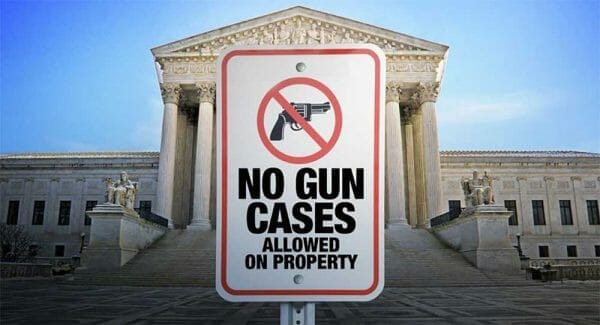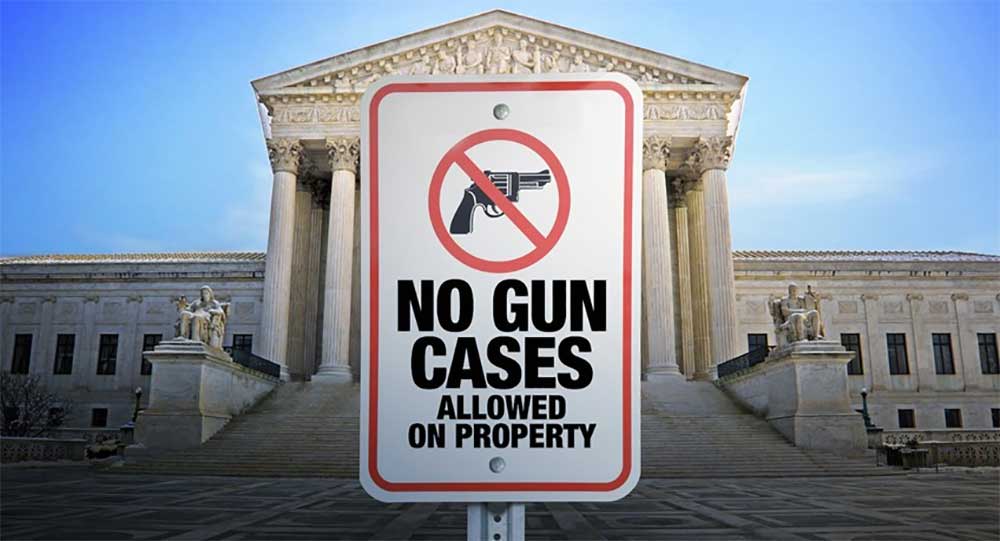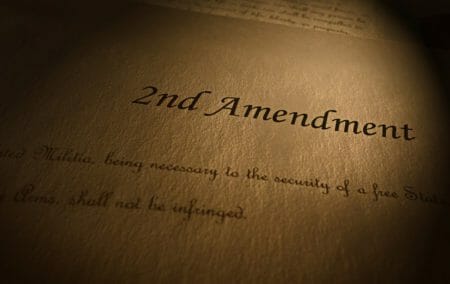
U.S.A. –-(AmmoLand.com)- From the moment Alan Gottlieb, founder and executive vice president of the Second Amendment Foundation, said in a prepared statement following the Supreme Court’s rejection of ten pending gun rights cases, that responsibility for this high court two-step “falls squarely at the feet of Chief Justice John Roberts,” the question that must be answered is this:
“Is the chief justice of the U.S. Supreme Court afraid of restoring the Second Amendment to apply equally to all citizens?” It is beginning to appear that way.
The National Rifle Association issued a statement: “The Bill of Rights specifically includes the right to keep and bear arms because self-defense is fundamental to the liberty of a free society. Today’s inaction continues to allow so-called gun safety politicians to trample on the freedom and security of law-abiding citizens. This fight is not over for the NRA.”

Gottlieb was equally blunt, observing, “Given the fact that the Supreme Court had a cafeteria-style menu of cases from which to choose, there is no excuse why the court at this time chose to ignore the need to rule on any of these cases, and send a message to lower courts that they can no longer thumb their noses at the Heller and McDonald Supreme Court decisions affirming the individual right to keep and bear arms.”
Roberts’ appointment made the 5-4 Heller (2008) and McDonald (2010) Second Amendment opinions possible. His addition to the court enabled Justices Antonin Scalia and Samuel Alito to author opinions anyone can understand; the Second Amendment protects an individual fundamental right to keep and bear arms outside of any service in a militia.

But in the years since, lower courts have wrestled, incredulously as it might seem, with the question whether this right extends beyond the confines of one’s home. It is a question that needs to be answered sooner than later, especially considering a passage in Justice Clarence Thomas’ dissent, joined by Justice Brett Kavanaugh, in the court’s rejection of Rogers v. Grewal, one of the ten cases. This was a challenge to the New Jersey “justifiable need” requirement to obtain a carry permit in the Garden State.
“One of this Court’s primary functions is to resolve ‘important matter[s]’ on which the courts of appeals are ‘in conflict.”…The question whether a State can effectively ban most citizens from exercising their fundamental right to bear arms surely qualifies as such a matter. We should settle the conflict among the lower courts so that the fundamental protections set forth in our Constitution are applied equally to all citizens.”
The court’s reluctance to consider such a case that directly addresses the right “to bear arms” falls in Chief Justice Roberts’ lap, according to several observers, including SAF’s Gottlieb. At least one observer suggested to AmmoLand that Roberts does not care to take the Second Amendment beyond Heller. If that assessment is accurate, it’s an absurd position.
Could it be he doesn’t want to hear such a case because there can be but only one logical, and constitutionally correct, outcome; that such laws as now exist in New Jersey, New York and a handful of other states, would be nullified? It would throw those states’ regulatory schemes into chaos, which would delight gun rights activists living under those burdensome restrictions. But what other outcomes could there be, since the exercise of a fundamental, individual right requires no explanation or justification. A right is there to be exercised responsibly, regardless the misgivings of some bureaucrat or special interest group that thinks otherwise.
But by leaving intact, at least for the time being, such restrictions on an enumerated right, Roberts is relegating that right to the level of a regulated privilege.
If Roberts is satisfied with the status quo, and some observers believe he is, millions of law-abiding gun owners are not. They want to enjoy the same rights as citizens living in Indiana or Florida, Texas or Idaho, or any of the dozens of other states where one doesn’t need to provide a reason for exercising a constitutionally delineated right.
Justice Thomas is no stranger to this dilemma. In his 19-page dissent he wrote, “as I have noted before, many courts have resisted our decisions in Heller and McDonald… Instead of following the guidance provided in Heller, these courts minimized that decision’s framework…(concluding that our decisions “did not provide much clarity as to how Second Amendment claims should be analyzed in future cases”). They then “filled” the self-created “analytical vacuum” with a “two-step inquiry” that incorporates tiers of scrutiny on a sliding scale…) (compiling Circuit opinions adopting some form of the sliding-scale framework).
“Under this test,” Thomas continued, “courts first ask ‘whether the challenged law burdens conduct protected by the Second Amendment.’…If so, courts proceed to the second step—determining the appropriate level of scrutiny…To do so, courts generally consider “how close the law comes to the core of the Second Amendment right” and “the severity of the law’s burden on the right.”
“Depending on their analysis of those two factors, courts then apply what purports to be either intermediate or strict scrutiny— at least recognizing that Heller barred the application of rational basis review…
“This approach raises numerous concerns,” Thomas observed. “For one, the courts of appeals’ test appears to be entirely made up. The Second Amendment provides no hierarchy of “core” and peripheral rights. And “[t]he Constitution does not prescribe tiers of scrutiny.”
But the description of what has occurred correlates with Justice Thomas’ 2018 dissent in the high court’s refusal to hear the appeal in another Second Amendment case, Silvester v. Becerra. In that 14-page dissent, Justice Thomas observed, “If a lower court treated another right so cavalierly, I have little doubt that this Court would intervene. But as evidenced by our continued inaction in this area, the Second Amendment is a disfavored right in this Court.”
This brings Second Amendment activists back around to the appearance, the perception, that Chief Justice Roberts is fearful of advancing a rights case to the point that a high court ruling will be issued.
The question then becomes “Why?”
The nation’s gun owners, an estimated 100 million-plus citizens, are waiting for an answer.
About Dave Workman
Dave Workman is a senior editor at TheGunMag.com and Liberty Park Press, author of multiple books on the Right to Keep & Bear Arms and formerly an NRA-certified firearms instructor.






Very simple to follow the constitution, why can’t these judges just spell it out to anyone who tries to stop the second amendment and the rights to keep and bare arms.
I understand it as anywhere I should have to protect myself or my loved ones, not just at home.
If shotgun Joe should get elected over Trump we can expect to see liberal anti-gun folks screaming for the second amendment to be stricken from the constitution and a couple of liberal judges appointed to the court.
The Second Amendment does not need to be “restored”. It just needs to be followed as a rule
of law. As written. Our current state of insanity is one of the reasons it was written.
I wonder how big a stipend, IN-Justice Roberts, gets from “Little Mike” and Sorass, every time he rejects a 2A case.
this has nothing to do with the article written. please stay on topic and don’t ramble on.
There are LOTS of reasons to not take a case, and the least common reason is “we don’t think the case is important.” Virtually all the petitions for certiorari are “important.” Filing such a writ is a very expensive thing to do, and it isn’t done lightly. But still, every year the supreme court REJECTS 98% of the petitions, hearing less than 2% of the cases (some are done just on paper). One key factor in deciding whether to take up an issue is whether it has been fully litigated throughout the various Circuit Courts of Appeal, and if so… Read more »
Mr. Workman, Here is a quote from your good Op-Ed;
” This was a challenge to the New Jersey “justifiable need” requirement to obtain a carry permit in the Garden State.”
You MUST enter Maryland into this description. The state of Maryland REQUIRES a “REQUIRED PAYMENT partitioner” to have CURRENT COURT DOCUMENTATION of a personal IMMEDIATE THREAT as one of the REQUIREMENTS to obtain an EXPENSIVE EXTREMELY LIMITED CARRY PERMIT.